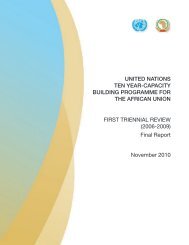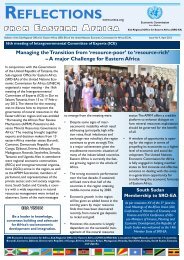A Decade of NEPAD - Economic Commission for Africa - uneca
A Decade of NEPAD - Economic Commission for Africa - uneca
A Decade of NEPAD - Economic Commission for Africa - uneca
You also want an ePaper? Increase the reach of your titles
YUMPU automatically turns print PDFs into web optimized ePapers that Google loves.
GDP Growth Rate (2004-2011)<br />
and the IMF’s Multilateral Debt Relief Initiative (MDRI)<br />
also helped <strong>Africa</strong>n nations to reallocate funding to more<br />
development fostering initiatives as external debt declined<br />
as a percentage <strong>of</strong> GDP from an average <strong>of</strong> 62.4% <strong>for</strong> 1998-<br />
2001 to 47.9% <strong>for</strong> 2000-2005 and down to 23.1% in 2007.<br />
Thus, between 1998 and 2007, these factors helped the<br />
continent record average growth rates <strong>of</strong> 4.3%, which<br />
although lower than Asian growth rates were higher than<br />
growth rates in Latin America and the Caribbean.<br />
Indicative <strong>of</strong> <strong>Africa</strong>’s overall economic resilience and growing<br />
internal economic drivers is the fact that although 2009<br />
is expected to be a below par GDP growth year, projections<br />
are that the continent’s 2011 GDP rates rebounded to 5%.<br />
In response to <strong>Africa</strong>’s strong economic growth, the continent<br />
has also increasingly attracted <strong>for</strong>eign direct investment<br />
and private capital. Between 2002 and 2007 <strong>for</strong>eign<br />
direct investment (FDI) into <strong>Africa</strong> rose strongly from less<br />
4. <strong>NEPAD</strong> and the <strong>Africa</strong>n Private Sector Today A <strong>Decade</strong> <strong>of</strong> <strong>NEPAD</strong><br />
Country 2004 2005 2006 2007 2008 2009 2010 2011<br />
Nigeria 10.6 5.4 6.2 7.0 6.0 7.0 7.4 7.4<br />
Benin 3.0 2.9 3.8 4.6 5.0 2.5 2.8 3.6<br />
Burkina Faso 4.5 8.7 5.5 3.6 5.2 3.2 4.4 4.7<br />
Cote D’Ivoire 1.6 1.9 0.7 1.6 2.3 3.8 3.0 4.0<br />
Gambia 7.0 0.3 3.4 6.0 6.3 5.6 5.0 5.4<br />
Ghana 5.6 5.9 6.4 5.7 7.2 4.1 5.0 9.9<br />
Guinea 2.3 3.0 2.5 1.8 4.9 -0.3 3.0 3.9<br />
Guinea-Bissau 3.1 5.0 2.2 0.2 3.6 3.0 3.5 4.3<br />
Liberia 2.6 5.3 7.8 9.4 7.1 4.6 6.3 9.5<br />
Mali 2.3 6.1 5.3 4.3 5.0 4.4 5.1 5.4<br />
Niger -0.8 8.4 5.8 3.4 8.7 -1.2 3.5 5.2<br />
Sierra Leone 6.6 5.7 6.7 6.0 5.5 3.2 4.5 5.2<br />
Togo 2.3 1.2 3.7 1.9 2.2 3.1 3.3 3.5<br />
Source: ECA (2012), <strong>Economic</strong> Report on <strong>Africa</strong><br />
than US$20 billion to a record <strong>of</strong> US$53 billion. US$22.4<br />
billion <strong>of</strong> FDI was invested by trans-national companies<br />
in North <strong>Africa</strong> and US$30.6 billion was invested in Sub-<br />
Saharan <strong>Africa</strong>. Even during the recessive period <strong>of</strong> 2008<br />
when global FDI fell by 20%, FDI in <strong>Africa</strong> remained<br />
resilient, rising by 16.8% to US$61.9 billion. Mergers and<br />
acquisitions in <strong>Africa</strong> also continued to rise, growing by<br />
157% between 2007 and 2008 to US$26 billion. Furthermore,<br />
the rate on return on investment in <strong>Africa</strong> has been<br />
increasing annually since 2004 registering 12.1% in 2007,<br />
giving the continent the highest global investment rate <strong>of</strong><br />
return among developing nations.<br />
Most <strong>of</strong> the investment attracted to <strong>Africa</strong>, however, has<br />
remained focused on countries that have significant natural<br />
mineral and petroleum resources. This has skewed <strong>for</strong>eign<br />
direct investment to a relatively narrow group <strong>of</strong> countries<br />
and also has impacted upon which regions attract the<br />
lion’s share <strong>of</strong> FDI:<br />
41







